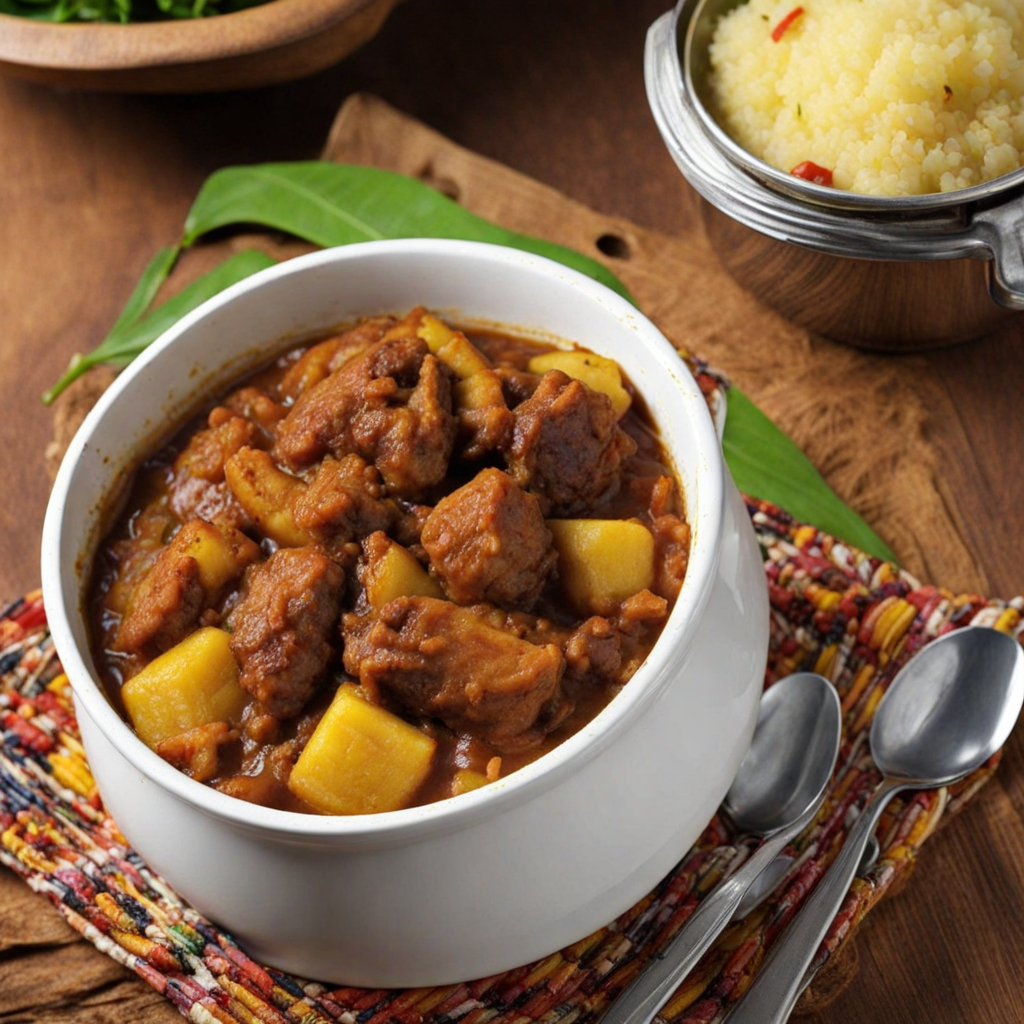Umuceri n'ibishyimbo
Umuceri n'ibishyimbo is a traditional Rwandan dish that beautifully combines the simplicity of rice with the heartiness of beans. The rice, typically long-grain or sometimes jasmine, is cooked to fluffy perfection, allowing it to absorb the subtle flavors of the accompanying ingredients. The beans, often red or black varieties, are simmered until tender, creating a creamy texture that complements the rice. This dish is not just a staple but a celebration of the earth's bounty, embodying the sustainable agricultural practices prevalent in Rwanda.
How It Became This Dish
Umuceri n'ibishyimbo: A Culinary Journey Through Rwanda Umuceri n'ibishyimbo, a traditional Rwandan dish, is a simple yet profound emblem of the country's culinary heritage. The dish, which translates to "rice and beans," is more than just a meal; it reflects the agricultural practices, social structures, and historical influences that have shaped Rwandan culture over centuries. To appreciate Umuceri n'ibishyimbo fully, one must delve into its origins, cultural significance, and the evolution of this beloved dish. Origins The origins of Umuceri n'ibishyimbo can be traced back to the agricultural practices of the Rwandan people, who have cultivated crops for thousands of years. The fertile volcanic soils of Rwanda’s mountainous regions, coupled with a favorable climate, created ideal conditions for growing various staples. Among these staples, beans and rice emerged as vital components of the local diet. Beans, particularly the common bean (Phaseolus vulgaris), have been cultivated in Rwanda since the pre-colonial era. They were introduced to the region from the Americas by European colonizers in the 16th century. Over time, the Rwandans adapted their cultivation methods and incorporated beans into their diet as a significant source of protein. Rice, on the other hand, has a more complex history in Rwanda. While indigenous grains like millet and sorghum were traditionally consumed, rice was introduced later, during the colonial period. The Belgian colonial administration, keen on developing agricultural exports, promoted rice cultivation in the wetlands of the country. By the mid-20th century, rice had become a staple food, complementing the already popular beans. Cultural Significance Umuceri n'ibishyimbo holds a special place in Rwandan culture, symbolizing sustenance and community. It is often served during family gatherings, celebrations, and communal events, reinforcing social bonds among family members and friends. The dish is emblematic of the Rwandan way of life, where sharing food is a fundamental aspect of hospitality and kinship. In Rwandan society, food serves as a means of expressing love and care. The preparation of Umuceri n'ibishyimbo often involves the participation of multiple family members, from washing and sorting the beans to cooking the rice. This communal effort fosters a sense of togetherness and strengthens familial relationships. Traditional Rwandan homes often feature communal eating practices, where families gather around a single dish, emphasizing the importance of sharing and unity. Moreover, Umuceri n'ibishyimbo is deeply intertwined with Rwandan identity. It reflects the agricultural heritage of the nation and the resilience of its people. Despite historical challenges, including colonialism and the devastating genocide of 1994, the Rwandan people have maintained their cultural practices, with Umuceri n'ibishyimbo standing as a testament to their culinary resilience. Development Over Time Since its inception, Umuceri n'ibishyimbo has evolved alongside the changing socio-economic landscape of Rwanda. After the genocide in 1994, the country underwent a period of reconstruction and healing. During this time, the importance of traditional foods was re-emphasized as a way to foster national unity and pride. Umuceri n'ibishyimbo emerged as a symbol of hope and recovery, representing the enduring spirit of Rwandans. In recent years, the dish has also gained recognition beyond Rwanda's borders. As global interest in African cuisine has surged, Umuceri n'ibishyimbo has found its way into restaurants and culinary platforms worldwide. Chefs and food enthusiasts have started to appreciate the dish's simplicity and nutritional value, helping to elevate its status on the global culinary stage. The dish has also undergone variations based on regional ingredients and contemporary culinary practices. While traditional Umuceri n'ibishyimbo typically features plain rice and boiled beans, modern interpretations may include spices, vegetables, and proteins such as meat or fish. These adaptations are a reflection of the growing influence of globalization on local cuisine, as Rwandans experiment with fusion dishes that incorporate international flavors while retaining the essence of their culinary heritage. Nutritional Value From a nutritional perspective, Umuceri n'ibishyimbo is a powerhouse. The combination of rice and beans provides a complete source of protein, essential for maintaining health and wellbeing. This aspect is particularly significant in Rwanda, where food security and nutrition are ongoing challenges. By incorporating this dish into their diets, Rwandans can ensure they receive the necessary nutrients to support their active lifestyles. The dish is also highly versatile and can be prepared in various ways to accommodate personal preferences. For instance, some may choose to cook the beans with spices or vegetables to enhance the flavor profile. The addition of ingredients like tomatoes, onions, and garlic can transform the dish into a vibrant, aromatic experience, showcasing the creativity of Rwandan cooks. Conclusion Umuceri n'ibishyimbo is more than just a staple food in Rwanda; it is a reflection of the nation's history, culture, and resilience. From its humble beginnings as a peasant dish to its current status as a symbol of Rwandan identity, it encapsulates the spirit of community and sustenance that defines Rwandan life. As the world continues to embrace diverse culinary traditions, Umuceri n'ibishyimbo stands as a testament to the rich tapestry of Rwandan culture, inviting people to experience its flavors and stories. In a globalized world where culinary boundaries are increasingly blurred, Umuceri n'ibishyimbo remains a poignant reminder of the importance of food in forging connections, understanding heritage, and celebrating the beauty of simplicity in sustenance.
You may like
Discover local flavors from Rwanda







